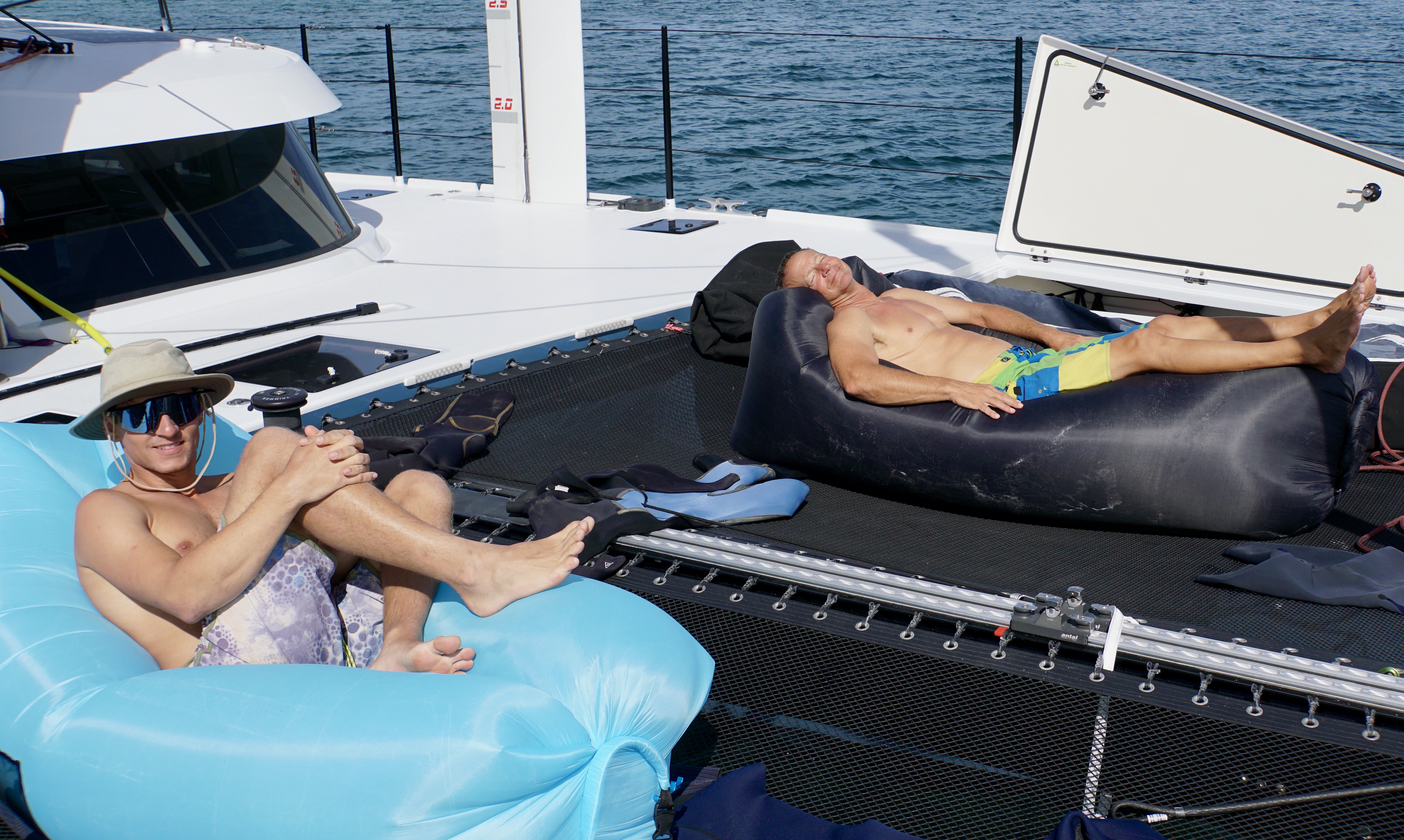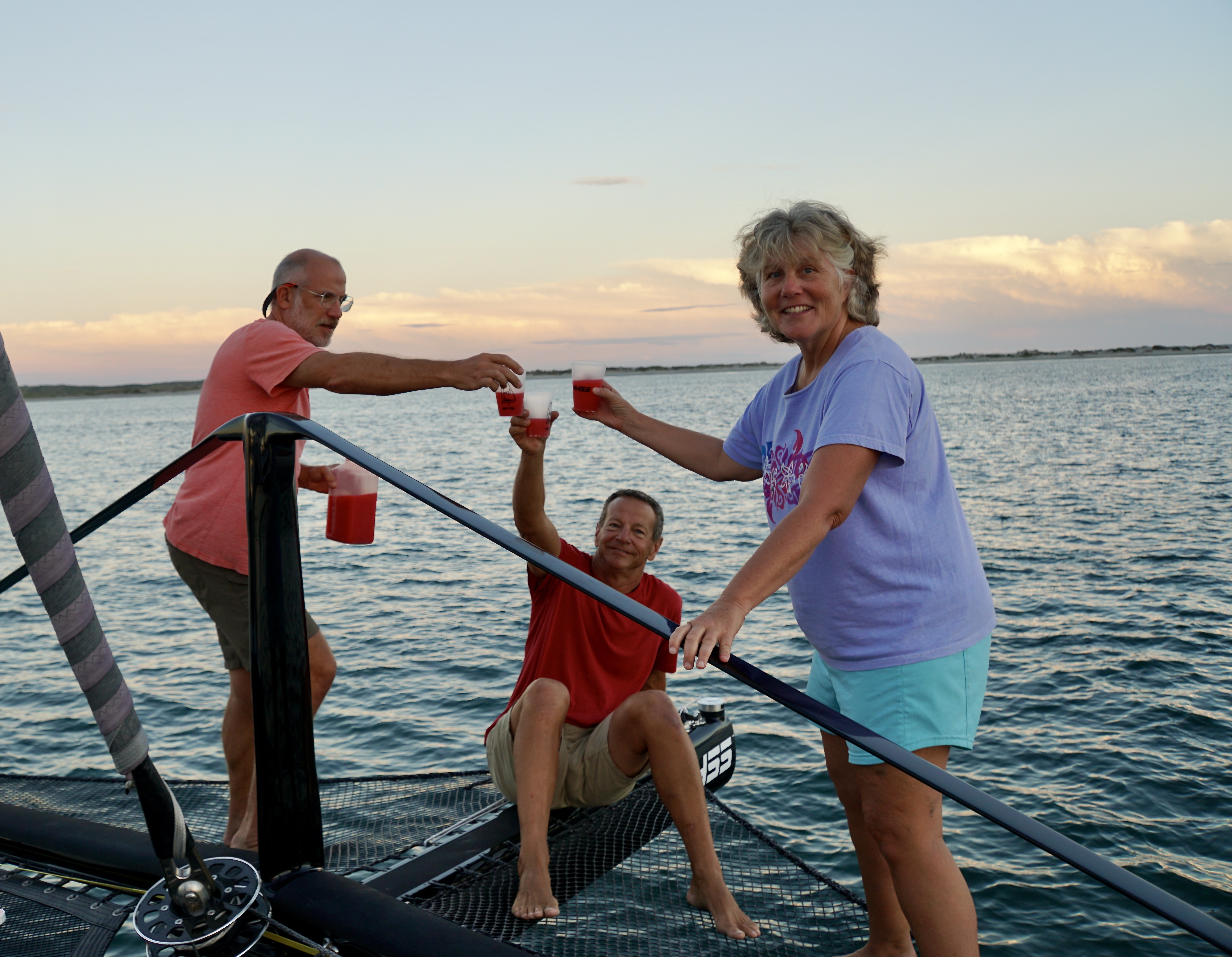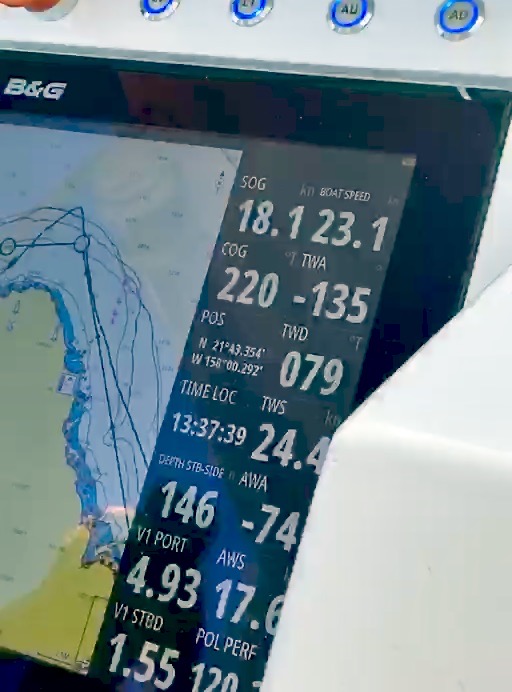Fairly often we are asked why we sold our 44′ Fountaine Pajot catamaran, Let It Be, and bought our Hudson Hakes 55′ catamaran, Ticket to Ride. The follow up questions are usually “how different are the boats?” and “was the change worth it?”
Well the answers are pretty involved, but we must begin by saying that Frank and I would probably not have ordered an HH55 unless we were certain the cruising lifestyle worked for us. I have read that as few as 30 percent of couples who decide to live on a boat for an extended time actually complete their plan. That means about 70 percent of the partners who begin this journey do not enjoy it enough to continue as long as they planned. Before investing in Ticket to Ride, we had already learned that we enjoyed the cruising lifestyle and that it would be a long term choice for us.
Let It Be was a trustworthy boat and clearly capable of the circumnavigation recently completed on an FP 44′ by our friends Amy and David of s/v Out Chasing Stars. So obviously our decision was driven by other factors.
Rather, we were in search of three things: more space, more speed and more sailing. Plus there was a strong “why not?” factor.
Recently I read a well written blog about a couple who found cruising just wasn’t for them . The main complaints were that their boat was slow, they were the last to arrive at a destination and their motor use/sail use proportion was 73 motor/27 sail. That would be very frustrating.
The difference in how often we sail Ticket to Ride versus Let It Be is tremendous, especially because now we can sail well to windward. Clearly having dagger boards rather than mini keels is a huge advantage in sailing to windward. Combine the excellent design of our hull and dagger boards with the piercing bows and significant sail plan on TTR and we find that we sail much more than we motor. At wind angles that allow sailing, TTR usually sails faster than she can motor. Overall on TTR, I would estimate that we sail 70-80 percent of the time and here in Hawaii that percentage has risen to about 90.
I remember a particularly frustrating day when we were sailing Let It Be from Barbuda back to Antiqua. The day was beautiful but the sail was upwind and we had to tack and tack and tack because the best we could point on LIB was about 73 degrees true and 52 degrees apparent. At those angles we also suffered from side slipping so achieving our destination was time consuming and frustrating.
Later we bought some very nice North 3Di sails for Let It Be and we improved our apparent wind angle capability by about 5 degrees (68 true/47 apparent) but those angles still didn’t allow us to head to wind well and often we used our motor(s) to help.
The angles I’ve mentioned are probably pretty standard for production cats with mini-keels, so there is no shame in those numbers for Fountaine Pajot. We thoroughly enjoyed our Fountaine Pajot and are very glad LIB was our first sailboat.
Sailing Ticket to Ride is completely different because even in ocean waves we can sail at 47-50 degrees true wind angle with an apparent wind angle of about 29-30 degrees. Combine those tighter wind angles with the dagger boards which keep us from side slipping, and we actually sail where we are pointing.
Clearly pointing better allows us to sail much more directly to our destinations without using engines and that reduces frustration and improves our arrival time.
When we were route planning on LIB, we would hope to average 6 to 6.5 knots but on passage our average number of nautical miles per 24 hours tended to be about 140 or 5.8 knots of boats speed. I’m certain others with a FP Helia have better speed averages, but we were conservative about sailing a socked assymetric spinnaker at night, so that lowered our average speeds.
On Ticket to Ride, we route plan anticipating an average boat speed of 8.5 to 9 knots but we usually have better speeds than that and end up arriving earlier than expected. On TTR a 200 nm day (8.3 average) is casual and routine sailing and we have had several comfortable 250 nm days (10.42 average).
The really nice thing about the faster speeds of TTR is that what are overnight sails for many boats often become long day sails for us. This means we don’t hesitate to “pop over” to anchorages that on LIB would have required an overnight or partial night passage. Faster sailing brings more opportunities and willingness to explore additional anchorages.
The other obvious advantage of sailing faster in TTR is that our passage time is shorter so our exposure to weather is shorter. Although we do our best to avoid bad weather, if we encounter systems, we have a better chance of outrunning or avoiding storms on Ticket to Ride than we did on Let It Be.
In the article I referenced above, my take away was that two of the main frustrations were first how slow the boat sailed: “It’s pretty demoralizing to be passed by every boat on the sea, especially when it was rough out.” The second frustration was that they only sailed 20-27 percent of the time and the rest was spent motoring or motor sailing.
I completely understand how frustrating that would be and I think I would also want to throw in the towel or move to a motor cat if we were always using the motor and our speeds were slow.
The standard rigging on the HH55 is more sophisticated and precise than it was on our FP. One example is that the HH55 rigging uses Karver Hooks for reefing the main sail. Karver Hooks are fixed to the boom and attached to the mainsail through a designated loop. The benefit of the hook is that the reef is always in the same place and the reef in the sail is clean and properly aligned every time.**
On Let It Be, we had the standard 2:1 main halyard held in place with clutches and, while we could reef from the helm, our reef point varied depending on how tightly it was pulled and how well the line ran. Our reefs on LIB were not always clean and well aligned, especially at night when we could not see well.
Another example of more sophisticated rigging is the use of halyard locks for sail lines. Once we raise a sail, we make sure it is engaged in the halyard lock, then release all the pressure from the line. The sail is held aloft by the locking mechanism rather than by tension on a line. Learning to use the locks took very little practice and the benefits are; our lines are not under load when the sail is up, we have a shorter halyard because it is a 1:1 ratio instead of 2:1 length ratio, and the diameter of the line is much smaller. Removing the load from the halyards also lengthens the life of the lines and clutches.**
There are some performance sailboats that bring speed to the table but sacrifice interior space and amenities to make sure the boat remains light. We looked at a couple of performance cats that were longer overall than the HH55 but they had less interior space than our 44′ FP. The HH55 definitely has more room than our FP had.
The designer for this HH Catamaran, Morrelli and Melvin, has a long history of go fast boats including several Gunboats. The Gunboats I have seen are fast and modern, but somewhat spartan inside. Our HH is fast but also has all the luxuries we want for living aboard our boat. We think Morrelli and Melvin’s HH55 design is the perfect combination of speed and space still manageable for a couple.
When discussing the strengths of our HH, we must include the materials and manufacturing of the boat. This cat is made of carbon fiber which is strong and light. The boat has very little flex and is extremely quiet under sail – no creaking in the rigging. We have greater confidence in the strength of this boat than we did in our fiberglass sailboat. Every part manufactured at HH is cut using a CNC machine so the fit of the parts is excellent and we have confidence that each part is made to the proper specifications.
Finally, let’s talk about the “why not” factor. Frank worked very hard to provide excellent care for his patients and have a successful business. We were conservative stewards of his income and, while we lived well, we rarely spent our money on flashy cars or a lot of extremely high end items.
When considering a new sailboat, we definitely decided to let go of our circumspect mentality and buy the boat we wanted without regard to the statement it made. We sort of said, “why not” get what we want and not worry about how others perceive our choice. We decided the HH55 worked within our budget and we were going to go for it.
When looking for a new boat, we were at a point in our sailing where we could maintain our level of experience and buy a larger production boat; or we could step up the performance of the boat and our experience level by sailing a faster and slightly more sophisticated boat. We wanted to challenge ourselves and grow through the new boat.
I was more hesitant about the image of an expensive boat than Frank was, but we are extremely happy with our HH and wouldn’t change our decision. Although I was concerned the boat might put people off, she has actually increased the number of people we meet. TTR is rather eye catching and folks tend to paddle up, motor up, or approach us dockside to ask about TTR. We love meeting new people this way and sharing TTR with friends. With her ample space, Ticket to Ride is often the gathering place for sundowners or dinners and we like creating those memories and sharing our floating home.









Pictures of just a few of our guests over the last 21 months.
One final “why not” note; we both feel the importance of “loving your boat.” Big or small, mono or cat, white, pink or blue, when you approach your boat in the dinghy or welcome guests on your boat, we feel it is important to “love your boat.” We liked LIB for introducing us to the cruising lifestyle and taking us to many beautiful places. However, having the opportunity to build our own boat that meets our personal cruising needs and even have it painted the color of our choice all added to our “boat love” category.
Living on a sailboat is not all sunset cruises with umbrella drinks. Routine chores take much longer than on land and require more effort; like walking to the grocery and carrying your groceries on your walk home. Power and water must be monitored and carefully used; no more 20 minute showers with unlimited hot water. Moving from point A to point B takes a long time and if you don’t learn to enjoy the process of sailing to get to point B, you will probably not enjoy cruising. If you are a “type A” person you will need to learn to let go of the reins; a schedule is your enemy. Nature, not you, determines your timing.
Cruising is definitely more challenging than living on land and it takes some time to adjust to moving at a slower pace and expending great effort to do things that were so easy on land.
For Frank and me, sailing has worked very well. We have learned to enjoy the slower pace and embrace the rhythms of nature that guide our decisions. We have adjusted to spending all of our time together and we have become a team, focusing on the same goals.
I hope this offers a little understanding of why we chose to move from our Helia 44 to the HH55. If you have questions, feel free to write them in the comments and we will do our best to respond.
**These features may not be included in the 55′ Ocean Series or the HH50 Catamarans.
Thank you for stopping by to read our blog. If you would like to hear from us more often, please look at our FB page or follow us on Instagram.












Two thoughts;
First, in light winds your boat will outperform other heavier boats, and allow you to sail while others must
motor sail – yet another huge advantage for performance oriented boats.
Second, I think the warm, open smiles everyone gets upon meeting you two is as a big a factor as your great boat as to why your cruising experience has been so good – just the way it should be.
Love reading your blog! Looking forward to crossing wakes again some day.
LikeLiked by 1 person
Hey Chris! You are quite right about our ability to sail well in light winds. And thank you for your kind words in the second point.
We miss seeing you and Laura and sincerely hope we can get together…. it would be so so fun to share anchorages again! Ready to come to the Pacific yet? 😉
LikeLike
To me getting to the destination is as much fun as being at the destination so “Why Not” have the ability to do both with speed and style. I’m totally with your decision, so no slow condomaran for me either. Lisa and I had a great afternoon sailing on TTR! I think we were sailing at wind speed or better the entire time. Love your blog too!
LikeLike
David, that was such a fun day and I think Lisa was very comfortable the whole day! Yeah, I don’t see you as a “condomaran” kind of guy.
Thanks for reading and your kind words. I hope we get to see y’all again sometime in the near future. Stay well and hugs to you both.
LikeLike
Mary Grace you have the gift of writing! I enjoyed hearing of your beautiful life together! I think you two made a great choice.
LikeLiked by 1 person
Aww, thank you, Maggie. Sending hugs your way. ❤️
LikeLike
I could have written myself this post, meaning I agree 100% on what you say ..impressive the performance of your 55 !
LikeLiked by 1 person
Thanks for reading our blog, Giorgio. Sounds like you follow the HH Cats…. anything we missed?
LikeLike
Mary Grace,
Love your stories!
Where will you be May, June?
We are planning to be sailing in Bahamas and Cuba.
Lots to discuss about your great adventures since we met in China.
David & Jenni.
LikeLike